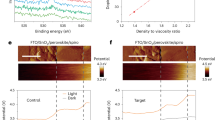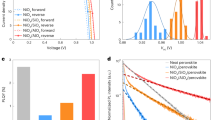Abstract
The efficiency and stability of perovskite solar cells are essentially determined by defects in the perovskite layer, yet their chemical nature and linking with the degradation mechanism of devices remain unclear. Here we uncover where degradation occurs and the underlying mechanisms and defects involved in the performance degradation of p–i–n perovskite solar cells under illumination or reverse bias. Light-induced degradation starts with the generation of iodide interstitials at the interfacial region between the perovskite and both charge transport layers. While we observe trap annihilation of two types of iodide defect at the anode side, we find negatively charged iodide interstitials near the cathode side, which we show to be more detrimental to the solar cell efficiency. The reverse-bias degradation is initialized by the interaction between iodide interstitials and injected holes at the interface between the electron transport layer and the perovskite. Introducing a hole-blocking layer between the layers suppresses this interaction, improving the reverse-bias stability.
This is a preview of subscription content, access via your institution
Access options
Access Nature and 54 other Nature Portfolio journals
Get Nature+, our best-value online-access subscription
$29.99 / 30 days
cancel any time
Subscribe to this journal
Receive 12 digital issues and online access to articles
$119.00 per year
only $9.92 per issue
Buy this article
- Purchase on Springer Link
- Instant access to full article PDF
Prices may be subject to local taxes which are calculated during checkout





Similar content being viewed by others
Data availability
All data generated or analysed during this study are included in the article, its Supplementary Information and its data source. Source data are provided with this paper.
References
Queisser, H. J. & Haller, E. E. Defects in semiconductors: some fatal, some vital. Science 281, 945–950 (1998).
Jin, H. et al. It’s a trap! On the nature of localised states and charge trapping in lead halide perovskites. Mater. Horizons 7, 397–410 (2020).
Ball, J. M. & Petrozza, A. Defects in perovskite-halides and their effects in solar cells. Nat. Energy 1, 16149 (2016).
Ono, L. K., Liu, S. F. & Qi, Y. Reducing detrimental defects for high‐performance metal halide perovskite solar cells. Angew. Chem. Int. Ed. 59, 2–25 (2020).
Best research-cell efficiency chart. NREL https://www.nrel.gov/pv/cell-efficiency.html (2021).
Chen, B., Rudd, P. N., Yang, S., Yuan, Y. & Huang, J. Imperfections and their passivation in halide perovskite solar cells. Chem. Soc. Rev. 48, 3842–3867 (2019).
Gao, F., Zhao, Y., Zhang, X. & You, J. Recent progresses on defect passivation toward efficient perovskite solar cells. Adv. Energy Mater. 10, 1902650 (2020).
Aydin, E., De Bastiani, M. & De Wolf, S. Defect and contact passivation for perovskite solar cells. Adv. Mater. 31, e1900428 (2019).
Yang, S. et al. Stabilizing halide perovskite surfaces for solar cell operation with wide-bandgap lead oxysalts. Science 365, 473–478 (2019).
Lin, Y.-H. et al. A piperidinium salt stabilizes efficient metal-halide perovskite solar cells. Science 369, 96–102 (2020).
Hui, Y. et al. Stability of perovskite thin films under working condition: bias‐dependent degradation and grain boundary effects. Adv. Funct. Mater. 31, 2103894 (2021).
Hailegnaw, B., Sariciftci, N. S. & Scharber, M. C. Impedance spectroscopy of perovskite solar cells: studying the dynamics of charge carriers before and after continuous operation. Phys. Status Solidi A 217, 2000291 (2020).
Xie, H. et al. Decoupling the effects of defects on efficiency and stability through phosphonates in stable halide perovskite solar cells. Joule 5, 1246–1266 (2021).
Wu, J. et al. Quantifying the interface defect for the stability origin of perovskite solar cells. Adv. Energy Mater. 9, 1901352 (2019).
Yin, W.-J., Shi, T. & Yan, Y. Unusual defect physics in CH3NH3PbI3 perovskite solar cell absorber. Appl. Phys. Lett. 104, 063903 (2014).
Meggiolaro, D. et al. Iodine chemistry determines the defect tolerance of lead-halide perovskites. Energy Environ. Sci. 11, 702–713 (2018).
Du, M.-H. Density functional calculations of native defects in CH3NH3PbI3: effects of spin–orbit coupling and self-interaction error. J. Phys. Chem. Lett. 6, 1461–1466 (2015).
Motti, S. G. et al. Controlling competing photochemical reactions stabilizes perovskite solar cells. Nat. Photon. 13, 532–539 (2019).
Zhang, X., Turiansky, M. E., Shen, J.-X. & Van de Walle, C. G. Iodine interstitials as a cause of nonradiative recombination in hybrid perovskites. Phys. Rev. B 101, 140101 (2020).
Reichert, S. et al. Probing the ionic defect landscape in halide perovskite solar cells. Nat. Commun. 11, 6098 (2020).
Tan, S. et al. Shallow iodine defects accelerate the degradation of α-phase formamidinium perovskite. Joule 4, 2426–2442 (2020).
Wang, R. et al. Unraveling the surface state of photovoltaic perovskite thin film. Matter 4, 2417–2428 (2021).
Walter, T., Herberholz, R., Müller, C. & Schock, H. W. Determination of defect distributions from admittance measurements and application to Cu(In,Ga)Se2 based heterojunctions. J. Appl. Phys. 80, 4411–4420 (1996).
Ni, Z. et al. Resolving spatial and energetic distributions of trap states in metal halide perovskite solar cells. Science 367, 1352–1358 (2020).
Heath, J. T., Cohen, J. D. & Shafarman, W. N. Bulk and metastable defects in CuIn1−xGaxSe2 thin films using drive-level capacitance profiling. J. Appl. Phys. 95, 1000–1010 (2004).
Chen, Z. et al. Thin single crystal perovskite solar cells to harvest below-bandgap light absorption. Nat. Commun. 8, 1890 (2017).
Karlsson, M. et al. Mixed halide perovskites for spectrally stable and high-efficiency blue light-emitting diodes. Nat. Commun. 12, 361 (2021).
Awni, R. A. et al. Influence of charge transport layers on capacitance measured in halide perovskite solar cells. Joule 4, 644–657 (2020).
Futscher, M. H. et al. Quantification of ion migration in CH3NH3PbI3 perovskite solar cells by transient capacitance measurements. Mater. Horizons 6, 1497–1503 (2019).
Nguyen, H. T., Nguyen, D. D. & Spanget-Larsen, J. Ionic reaction products of iodine with pyridine, 4-methylpyridine, and 4-tert-butylpyridine in a polyethylene matrix. A FTIR polarization spectroscopic investigation. Chem. Phys. Lett. 716, 119–125 (2019).
Chen, P. et al. In situ growth of 2D perovskite capping layer for stable and efficient perovskite solar cells. Adv. Funct. Mater. 28, 1706923 (2018).
Huang, W., Sadhu, S. & Ptasinska, S. Heat- and gas-induced transformation in CH3NH3PbI3 perovskites and its effect on the efficiency of solar cells. Chem. Mater. 29, 8478–8485 (2017).
Zhang, W., Ensing, B., Rothenberg, G. & Raveendran Shiju, N. Designing effective solid catalysts for biomass conversion: aerobic oxidation of ethyl lactate to ethyl pyruvate. Green Chem. 20, 1866–1873 (2018).
Shao, Y., Xiao, Z., Bi, C., Yuan, Y. & Huang, J. Origin and elimination of photocurrent hysteresis by fullerene passivation in CH3NH3PbI3 planar heterojunction solar cells. Nat. Commun. 5, 5784 (2014).
Wang, Q. et al. Qualifying composition dependent p and n self-doping in CH3NH3PbI3. Appl. Phys. Lett. 105, 163508 (2014).
Chen, S., Xiao, X., Gu, H. & Huang, J. Iodine reduction for reproducible and high-performance perovskite solar cells and modules. Sci. Adv. 7, eabe8130 (2021).
Deng, Y. et al. Defect compensation in formamidinium–caesium perovskites for highly efficient solar mini-modules with improved photostability. Nat. Energy 6, 633–641 (2021).
Bowring, A. R., Bertoluzzi, L., O’Regan, B. C. & McGehee, M. D. Reverse bias behavior of halide perovskite solar cells. Adv. Energy Mater. 8, 1702365 (2018).
Razera, R. A. Z. et al. Instability of p–i–n perovskite solar cells under reverse bias. J. Mater. Chem. A 8, 242–250 (2020).
Chen, Y. & Zhou, H. Defects chemistry in high-efficiency and stable perovskite solar cells. J. Appl. Phys. 128, 060903 (2020).
Xiao, Z. et al. Giant switchable photovoltaic effect in organometal trihalide perovskite devices. Nat. Mater. 14, 193–198 (2015).
Samu, G. F. et al. Electrochemical hole injection selectively expels iodide from mixed halide perovskite films. J. Am. Chem. Soc. 141, 10812–10820 (2019).
Jiang, Q. et al. Enhanced electron extraction using SnO2 for high-efficiency planar-structure HC(NH2)2PbI3-based perovskite solar cells. Nat. Energy 2, 16177 (2016).
Christians, J. A. et al. Tailored interfaces of unencapsulated perovskite solar cells for >1,000 hour operational stability. Nat. Energy 3, 68–74 (2018).
Xie, L. et al. Revealing the compositional effect on the intrinsic long-term stability of perovskite solar cells. J. Mater. Chem. A 8, 7653–7658 (2020).
Lin, Y. et al. Excess charge-carrier induced instability of hybrid perovskites. Nat. Commun. 9, 4981 (2018).
Acknowledgements
This work was supported by the Center for Hybrid Organic Inorganic Semiconductors for Energy (CHOISE), an Energy Frontier Research Center funded by the Office of Basic Energy Sciences, Office of Science, within the US Department of Energy. We thank V. Blum in the Department of Mechanical Engineering and Material Science of Duke University for insightful discussions.
Author information
Authors and Affiliations
Contributions
J.H. and Z.N. conceived the idea and designed the experiments. Z.N., H.J., C.F., H.G., S.X., G.Y. and Q.J. fabricated the perovskite polycrystalline thin film solar cells. Z.N. and Y.L. synthesized the perovskite thin single crystals. Z.N. and S.X. carried out the measurements for the devices. Z.Y. performed the ALD for the devices. Y.Y. participated in data analyses and project discussion. Y.D. did the TPC measurement. Z.N. and J.H. wrote the Article, and all authors reviewed it.
Corresponding author
Ethics declarations
Competing interests
The authors declare no competing interests.
Additional information
Peer review information Nature Energy thanks the anonymous reviewers for their contribution to the peer review of this work.
Publisher’s note Springer Nature remains neutral with regard to jurisdictional claims in published maps and institutional affiliations.
Supplementary information
Supplementary Information
Supplementary Figs. 1–26, Notes 1–4, Table 1 and Refs. 1–4.
Source data
Source Data Fig. 1
Source data point for Fig. 1c.
Rights and permissions
About this article
Cite this article
Ni, Z., Jiao, H., Fei, C. et al. Evolution of defects during the degradation of metal halide perovskite solar cells under reverse bias and illumination. Nat Energy 7, 65–73 (2022). https://doi.org/10.1038/s41560-021-00949-9
Received:
Accepted:
Published:
Issue Date:
DOI: https://doi.org/10.1038/s41560-021-00949-9
This article is cited by
-
Surface-defect-passivation-enabled near-unity charge collection efficiency in bromide-based perovskite gamma-ray spectrum devices
Nature Photonics (2024)
-
Unraveling radiation damage and healing mechanisms in halide perovskites using energy-tuned dual irradiation dosing
Nature Communications (2024)
-
Double-side 2D/3D heterojunctions for inverted perovskite solar cells
Nature (2024)
-
Multifunctional sulfonium-based treatment for perovskite solar cells with less than 1% efficiency loss over 4,500-h operational stability tests
Nature Energy (2024)
-
Bias-free solar NH3 production by perovskite-based photocathode coupled to valorization of glycerol
Nature Catalysis (2024)



